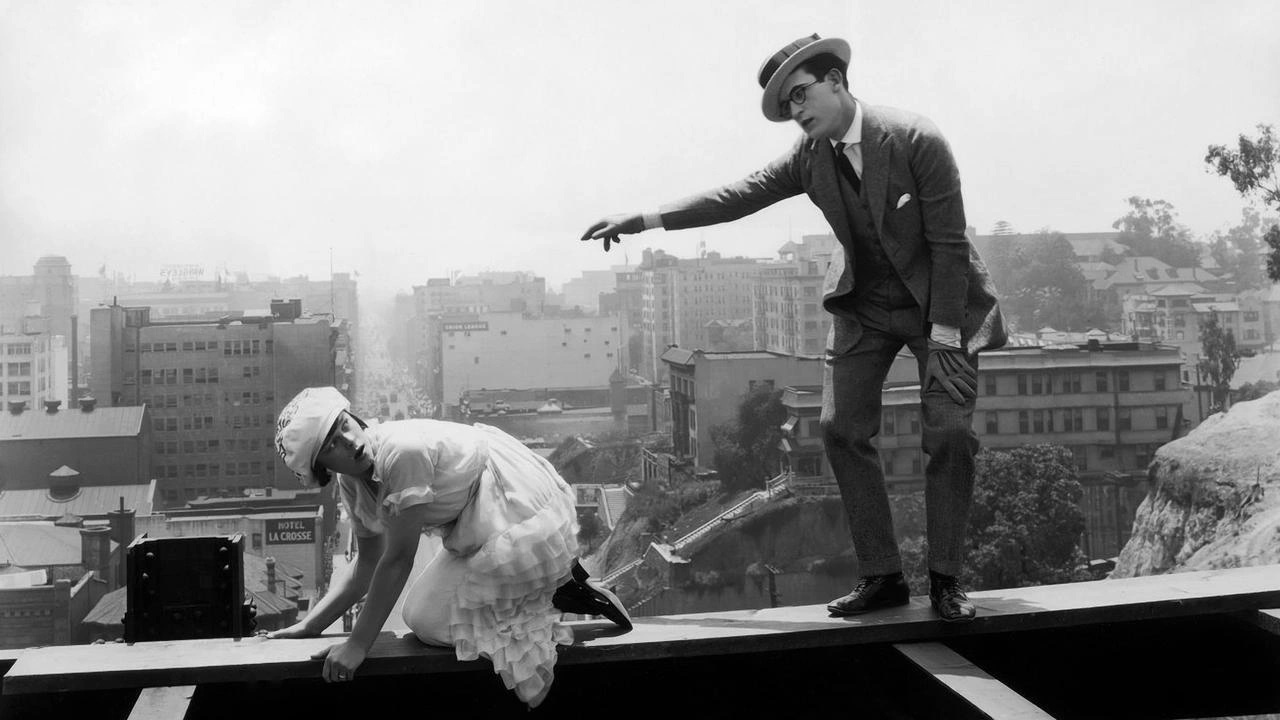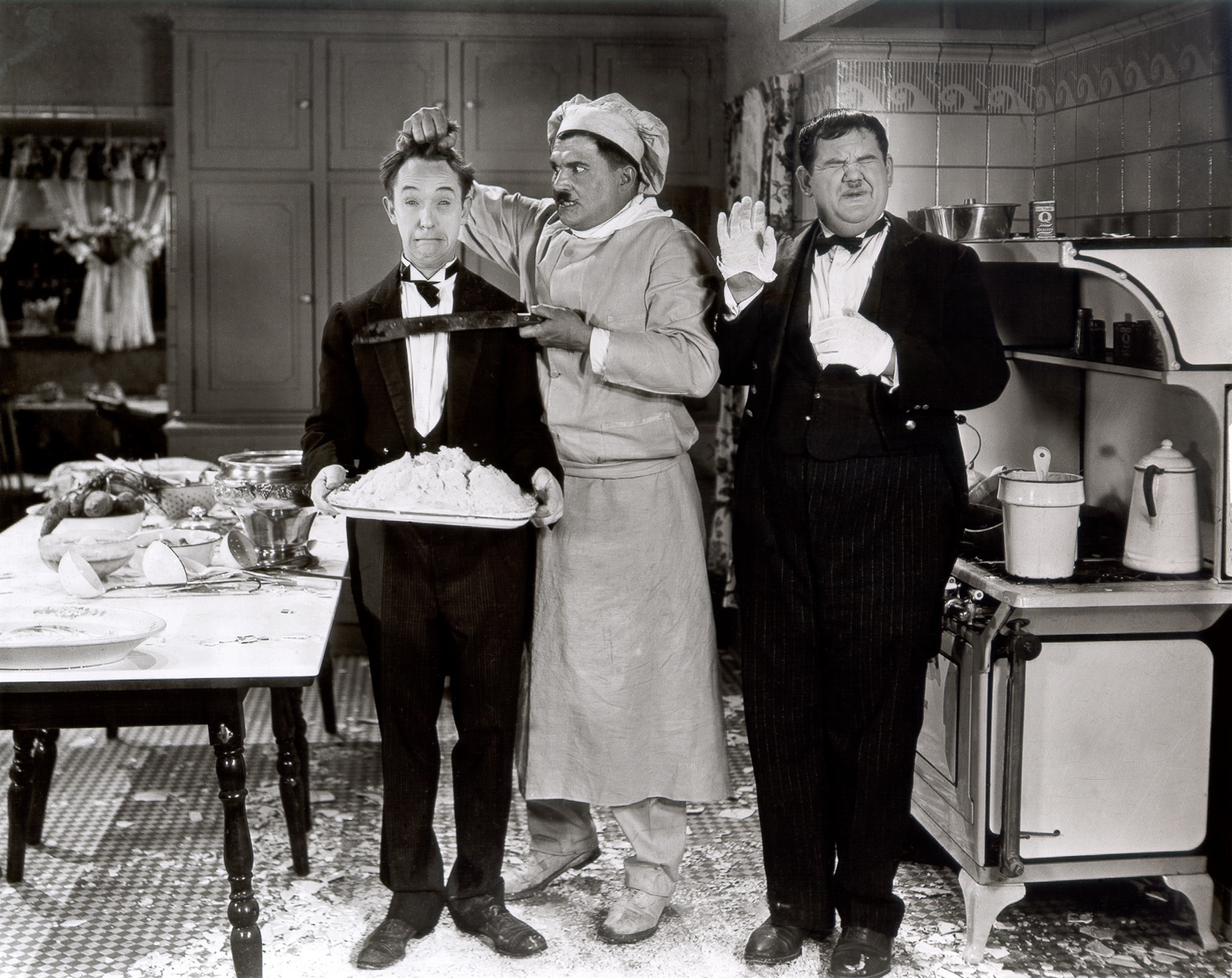This year’s silent film experiences in Sodankylä are rounded off by a hilarious classic comedy trio accompanied by Neil Brand. From Soup to Nuts liberates the chaos-prone duo hired for a fancy dinner party gig into a pre-Buñuel bourgeoisie salon. The lofty trappings of etiquette rules come down with a thunderous crash, with a spectacular line-up of banana peels and cream cakes, hot soup arching onto shoes and torn trouser seats, stained textiles and the threat of nudism culminating in the weepy Stan’s underwear round. The headband slipping over the eyes of the hostess (Anita Garvin) chasing a runaway cherry on her plate obscures only part of the mayhem wallowing around her, and in the attitudes of the working-class duo, who occasionally resemble a less tame Basil Fawlty of Fawlty Towers (1975-1979), a spark of class struggle can also be found, if desired.
Buster Keaton’s Cops is an ingenious combination of anarchy, absurdity, acrobatics, geometry, and pitch-black humour. Buster’s obtuse mistress immediately declares her desire for a rich, successful man, and the unreasonable demand drives Keaton into a maelstrom of mad logic mishaps. The barrage of sketches and stunts draws much of its power from the shape-shifting sets and props changing their form and meaning. The “bars” seen at the beginning turn out to be a mansion gate separating the lovers – and social classes – instead of those of a prison; Buster mistakes a bomb  thrown by an anarchist for a cigarette lighter and ends up stealing a large family’s moving load (believing that he has bought it) and hauling it along with the help of an old infirm nag in the middle of the throng of an urban parade. The film’s closing sequence – described by the comedian’s biographer Edward McPherson as “the most iconic of all comedy chases” – is a nonverbal visual ballet with insightful use of depth, during which the father of Buster’s beloved cries out in anguish, “Get some cops to protect our policemen!” The Beckettian ending – surrendering to be part of the “enemy” horde – leaves us with a sad impression, and the final image (let it come as a surprise) is quite chilling for the genre, but then love is a brutal art…
thrown by an anarchist for a cigarette lighter and ends up stealing a large family’s moving load (believing that he has bought it) and hauling it along with the help of an old infirm nag in the middle of the throng of an urban parade. The film’s closing sequence – described by the comedian’s biographer Edward McPherson as “the most iconic of all comedy chases” – is a nonverbal visual ballet with insightful use of depth, during which the father of Buster’s beloved cries out in anguish, “Get some cops to protect our policemen!” The Beckettian ending – surrendering to be part of the “enemy” horde – leaves us with a sad impression, and the final image (let it come as a surprise) is quite chilling for the genre, but then love is a brutal art…
Harold Lloyd’s final short film, the three-reel Never Weaken, forms something of a triptych, with the first episode showing Lloyd’s fiancée (the comedian’s future wife Mildred Davis) losing her job as an osteopath’s assistant. The supportive groom decides to advertise the troubled company by questionable means, crippling a significant number of people along the way, concurrently reviving the flow of customers. In the middle section of this comedy of errors, Lloyd mistakes his girlfriend’s priest brother for his rival and attempts suicide by almost any means available short of hiring a “Kaurismäkiesque contract killer.” In a vertigo-inducing climax, a construction beam from the skyscraper across the street transports Lloyd into the upper spheres and the man, having closed his eyes, first thinks he has passed from time to eternity. The effect is accentuated by an angelic caryatid adorning the house wall and a harpist’s celestial notes coming through a nearby window, but reality soon unfolds as even more challenging than before, and the comedian’s breath-taking balancing act on the edge of the abyss overwhelms any digital tricks that today’s hackers have coded.
 This unrivalled bundle of four geniuses will secure the ABCs of laughter long into the future and remind us, almost in the spirit of punk, of the importance of rebellion.
This unrivalled bundle of four geniuses will secure the ABCs of laughter long into the future and remind us, almost in the spirit of punk, of the importance of rebellion.
Lauri Timonen
Edward F. Cline, Buster Keaton: Cops (USA, 1922, 18 min)
Fred C. Newmeyer: Never Weaken (USA, 1921, 19 min)
Edgar Kennedy, Leo McCarey: From Soup to Nuts (USA, 1928, 20 min)
